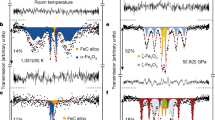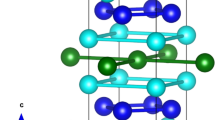Abstract
Magnetic anomalies associated with slowly cooled igneous and metamorphic rocks are commonly attributed to the presence of the mineral magnetite. Although the intermediate members of the ilmenite–haematite mineral series can also carry a strong ferrimagnetic remanence1, it is preserved only in rapidly cooled volcanic rocks, where formation of intergrowths of weakly magnetic haematite and paramagnetic ilmenite is suppressed. But the occurrence of unusually large and stable magnetic remanence in rocks containing such intergrowths has been known for decades2,3,4,5, and has recently been the subject of intense investigation6,7,8,9,10. These unmixed oxide phases have been shown to contain pervasive exsolution lamellae with thickness from 100 µm down to about 1 nm (one unit cell). These rocks, many of which contain only a few per cent of such oxides, show natural remanent magnetizations up to 30 A m-1—too strong to be explained even by pure haematite in an unsaturated state11,12. Here we propose a new ferrimagnetic substructure created by ferrous–ferric ‘contact layers’ that reduce charge imbalance along lamellar contacts between antiferromagnetic haematite and paramagnetic ilmenite. We estimate that such a lamellar magnetic material can have a saturation magnetization up to 55 kA m-1—22 times stronger than pure haematite—while retaining the high coercivity and thermal properties of single-domain haematite.
This is a preview of subscription content, access via your institution
Access options
Subscribe to this journal
Receive 51 print issues and online access
$199.00 per year
only $3.90 per issue
Buy this article
- Purchase on Springer Link
- Instant access to full article PDF
Prices may be subject to local taxes which are calculated during checkout



Similar content being viewed by others
References
Ishikawa, Y. & Akimoto, S. Magnetic property and crystal chemistry of ilmenite (MeTiO3) and hematite (αFe2O3) system II. Magnetic property. J. Phys. Soc. Jpn 13, 1298–1310 (1958)
Balsley, J. R. & Buddington, A. F. Iron titanium oxide minerals, rocks, and aeromagnetic anomalies of the Adirondack area, New York. Econ. Geol. 53, 777–805 (1958)
Hargraves, R. B. Magnetic anisotropy and remanent magnetism in hemo-ilmenite ore deposits at Allard Lake, Quebec. J. Geophys. Res. 64, 1565–1578 (1959)
Carmichael, C. M. The magnetic properties of ilmenite-hematite crystals. Proc. R. Soc. Lond. A 263, 508–530 (1961)
Merrill, R. T. & Grommé, C. S. Nonreproducible self-reversal of magnetization in diorite. J. Geophys. Res. 74, 2014–2024 (1969)
McEnroe, S. A. & Brown, L. L. A closer look at remanence-dominated aeromagnetic anomalies: Rock-magnetic properties and magnetic mineralogy of the Russell Belt microcline-sillimanite gneiss, northwest Adirondack Mountains. New York. J. Geophys. Res. 105, 16437–16456 (2000)
McEnroe, S. A., Harrison, R. J., Robinson, P., Golla, U. & Jercinovic, M. J. Effect of fine-scale microstructures in titanohematite on the acquisition and stability of natural remanent magnetization in granulite-facies metamorphic rocks southwest Sweden: Implications for crustal magnetism. J. Geophys. Res. 106, 30523–30546 (2001)
McEnroe, S. A., Robinson, P. & Panish, P. T. Detailed chemical and petrographic characterization of ilmenite-and magnetic-rich cumulates of the Sokndal region, Rogaland, Norway. Norweg. Geol. Surv. Bull. 436, 49–56 (2000)
McEnroe, S. A., Robinson, P. & Panish, P. T. Aeromagnetic anomalies, magnetic petrology and characterization of ilmenite-and magnetic-rich cumulates of the Sokndal region, Rogaland, Norway. Am. Mineral. 86, 1447–1468 (2001)
Robinson, P., Panish, P. T. & McEnroe, S. A. Minor element chemistry of hemo-ilmenite- and magnetite-rich cumulates from the Sokndal region, south Rogaland, Norway. Am. Mineral. 86, 1469–1476 (2001)
Banerjee, S. K. Magnetic properties of Fe-Ti oxides. Rev. Mineral. 25, 107–128 (1991)
Dunlop, D. J. & Özdemir, O. Rock Magnetism: Fundamentals and Frontiers (Cambridge Univ. Press, New York, 1997)
McEnroe, S. A., Robinson, P. & Panish, P. T. Correlation between oxide mineralogy, rock-magnetic properties and aeromagnetic anomalies: Case study from the Sokndal Region, South Norway. Eos 79, S362 (1998)
Harrison, R. J. Magnetic transitions in minerals. Rev. Mineral. 39, 175–202 (2000)
Harrison, R. J. & Becker, U. in Solid Solutions in Silicate and Oxide Systems (ed. Geiger, C. A.) Vol. 3, 349–383 (Notes in Mineralogy, European Mineralogical Union, Eötvös Univ. Press, Budapest, 2001)
Burton, B. P. The interplay of chemical and magnetic ordering. Rev. Mineral. 25, 303–321 (1991)
Kletetschka, G., Wasilewski, P. J. & Taylor, P. T. The role of hematite-ilmenite solid solution in the production of magnetic anomalies in ground and satellite-based data. Tectonophysics 347, 166–177 (2002)
Merrill, R. T. A possible source for the coercivity of ilmenite-hematite minerals. J. Geomag. Electr. 20, 181–185 (1968)
Acknowledgements
TEM imaging and TEM analytical studies at Institut für Mineralogie, Universitat Münster, were done in cooperation with A. Putnis and U. Golla, and atomic simulations were carried out in cooperation with U. Becker. Electron microprobe studies at Univ. Massachusetts were completed with assistance from P.T. Panish and M.J. Jercinovic. S.A.M. and P.R. were supported by the strategic research fund of the Geological Survey of Norway and Bayerisches Geo-Institut. The work of S.A.M. on Swedish granulites was initiated during a Fellowship from the American-Scandinavian Foundation and from the Institute of Rock Magnetism, and her work in the Adirondacks was supported by the NSF. R.J.H. carried out his studies while a research fellow at the Institut für Mineralogie, Universitat Münster.
Author information
Authors and Affiliations
Corresponding author
Ethics declarations
Competing interests
The authors declare that they have no competing financial interests.
Rights and permissions
About this article
Cite this article
Robinson, P., Harrison, R., McEnroe, S. et al. Lamellar magnetism in the haematite–ilmenite series as an explanation for strong remanent magnetization. Nature 418, 517–520 (2002). https://doi.org/10.1038/nature00942
Received:
Accepted:
Issue Date:
DOI: https://doi.org/10.1038/nature00942
This article is cited by
-
Crackling noise and avalanches in minerals
Physics and Chemistry of Minerals (2021)
-
Magnetism in cold subducting slabs at mantle transition zone depths
Nature (2019)
-
Synthesis and Magnetic Properties of Nanocrystalline FeTiO3 Materials
Journal of Superconductivity and Novel Magnetism (2018)
-
Exfoliation of a non-van der Waals material from iron ore hematite
Nature Nanotechnology (2018)
-
Electrostatic doping as a source for robust ferromagnetism at the interface between antiferromagnetic cobalt oxides
Scientific Reports (2015)
Comments
By submitting a comment you agree to abide by our Terms and Community Guidelines. If you find something abusive or that does not comply with our terms or guidelines please flag it as inappropriate.



